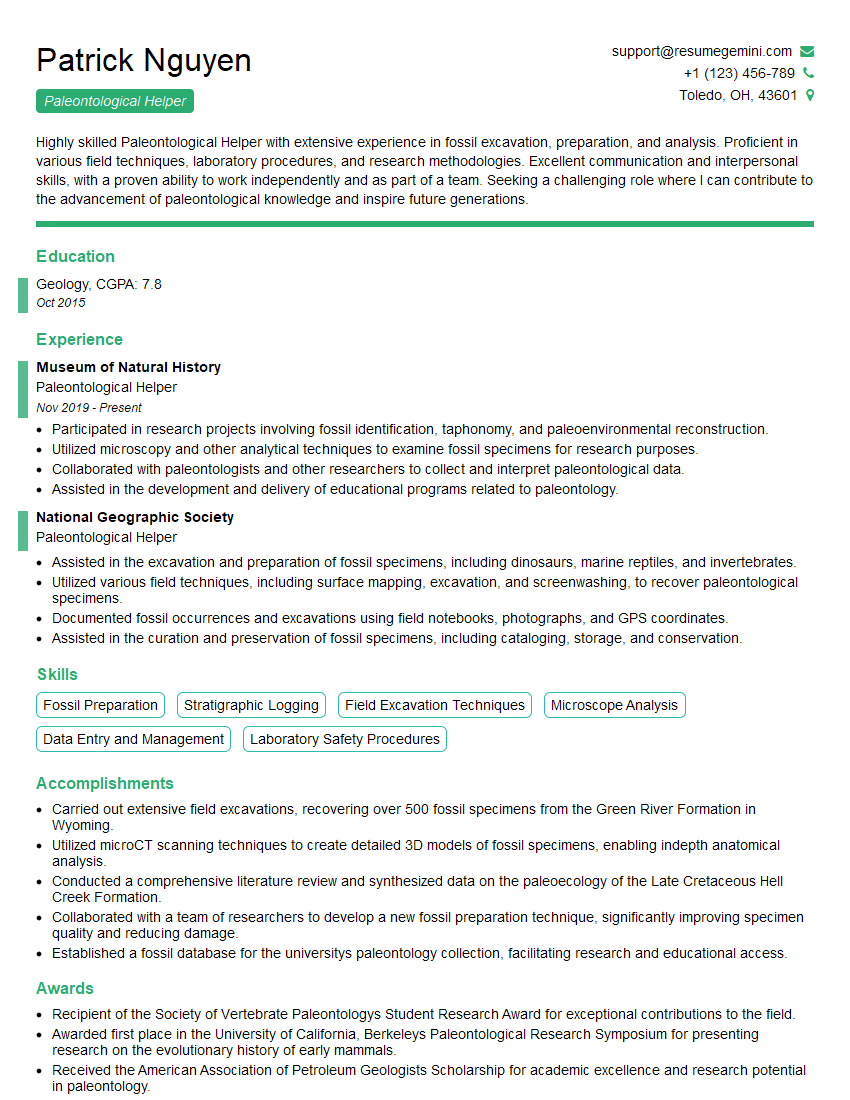Are you a seasoned Paleontological Helper seeking a new career path? Discover our professionally built Paleontological Helper Resume Template. This time-saving tool provides a solid foundation for your job search. Simply click “Edit Resume” to customize it with your unique experiences and achievements. Customize fonts and colors to match your personal style and increase your chances of landing your dream job. Explore more Resume Templates for additional options.

Patrick Nguyen
Paleontological Helper
Summary
Highly skilled Paleontological Helper with extensive experience in fossil excavation, preparation, and analysis. Proficient in various field techniques, laboratory procedures, and research methodologies. Excellent communication and interpersonal skills, with a proven ability to work independently and as part of a team. Seeking a challenging role where I can contribute to the advancement of paleontological knowledge and inspire future generations.
Education
Geology
October 2015
Skills
- Fossil Preparation
- Stratigraphic Logging
- Field Excavation Techniques
- Microscope Analysis
- Data Entry and Management
- Laboratory Safety Procedures
Work Experience
Paleontological Helper
- Participated in research projects involving fossil identification, taphonomy, and paleoenvironmental reconstruction.
- Utilized microscopy and other analytical techniques to examine fossil specimens for research purposes.
- Collaborated with paleontologists and other researchers to collect and interpret paleontological data.
- Assisted in the development and delivery of educational programs related to paleontology.
Paleontological Helper
- Assisted in the excavation and preparation of fossil specimens, including dinosaurs, marine reptiles, and invertebrates.
- Utilized various field techniques, including surface mapping, excavation, and screenwashing, to recover paleontological specimens.
- Documented fossil occurrences and excavations using field notebooks, photographs, and GPS coordinates.
- Assisted in the curation and preservation of fossil specimens, including cataloging, storage, and conservation.
Accomplishments
- Carried out extensive field excavations, recovering over 500 fossil specimens from the Green River Formation in Wyoming.
- Utilized microCT scanning techniques to create detailed 3D models of fossil specimens, enabling indepth anatomical analysis.
- Conducted a comprehensive literature review and synthesized data on the paleoecology of the Late Cretaceous Hell Creek Formation.
- Collaborated with a team of researchers to develop a new fossil preparation technique, significantly improving specimen quality and reducing damage.
- Established a fossil database for the universitys paleontology collection, facilitating research and educational access.
Awards
- Recipient of the Society of Vertebrate Paleontologys Student Research Award for exceptional contributions to the field.
- Awarded first place in the University of California, Berkeleys Paleontological Research Symposium for presenting research on the evolutionary history of early mammals.
- Received the American Association of Petroleum Geologists Scholarship for academic excellence and research potential in paleontology.
- Recognized for outstanding contributions to the universitys paleontology museum, assisting with specimen preparation and curation.
Certificates
- Certified Fossil Preparator
- OSHA Safety Certification
- National Association of Geoscience Teachers (NAGT) Member
- Certified Field Paleontologist
Career Expert Tips:
- Select the ideal resume template to showcase your professional experience effectively.
- Master the art of resume writing to highlight your unique qualifications and achievements.
- Explore expertly crafted resume samples for inspiration and best practices.
- Build your best resume for free this new year with ResumeGemini. Enjoy exclusive discounts on ATS optimized resume templates.
How To Write Resume For Paleontological Helper
- Highlight your passion for paleontology and your knowledge of the field.
- Quantify your accomplishments and provide specific examples of your work.
- Tailor your resume to each job you apply for, highlighting the skills and experience that are most relevant to the position.
- Proofread your resume carefully before submitting it.
- Network with other paleontologists and attend industry events to learn about new opportunities.
Essential Experience Highlights for a Strong Paleontological Helper Resume
- Assisted in the excavation and preparation of fossil specimens, including dinosaurs, marine reptiles, and invertebrates.
- Utilized various field techniques, including surface mapping, excavation, and screenwashing, to recover paleontological specimens.
- Documented fossil occurrences and excavations using field notebooks, photographs, and GPS coordinates.
- Assisted in the curation and preservation of fossil specimens, including cataloging, storage, and conservation.
- Participated in research projects involving fossil identification, taphonomy, and paleoenvironmental reconstruction.
- Utilized microscopy and other analytical techniques to examine fossil specimens for research purposes.
- Collaborated with paleontologists and other researchers to collect and interpret paleontological data.
Frequently Asked Questions (FAQ’s) For Paleontological Helper
What is a Paleontological Helper?
A Paleontological Helper assists paleontologists in the excavation, preparation, and analysis of fossils. They may also be involved in research projects, educational programs, and outreach activities.
What are the qualifications for a Paleontological Helper?
A Paleontological Helper typically has a bachelor’s degree in geology, paleontology, or a related field. They should also have strong field and laboratory skills, as well as excellent communication and interpersonal skills.
What are the job duties of a Paleontological Helper?
The job duties of a Paleontological Helper may include assisting with fossil excavation, preparation, and analysis; documenting fossil occurrences; curating and preserving fossil specimens; participating in research projects; and assisting with educational programs and outreach activities.
What are the career prospects for a Paleontological Helper?
Paleontological Helpers can advance to positions such as Paleontological Technician, Paleontological Preparator, or even Paleontologist. With additional education and experience, they may also be able to work in museums, universities, or government agencies.
How can I become a Paleontological Helper?
To become a Paleontological Helper, you will typically need to have a bachelor’s degree in geology, paleontology, or a related field. You should also develop strong field and laboratory skills, as well as excellent communication and interpersonal skills. Volunteering or interning with a paleontologist or at a museum can also be helpful.
What are the benefits of working as a Paleontological Helper?
Working as a Paleontological Helper can be a rewarding career for those who are passionate about paleontology. It offers the opportunity to work with fossils, contribute to scientific research, and educate the public about the history of life on Earth.